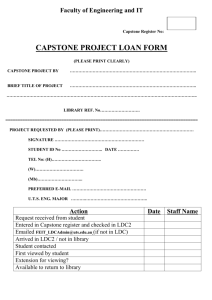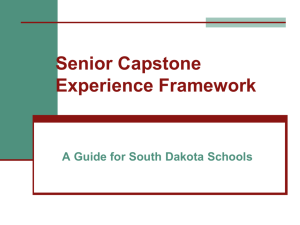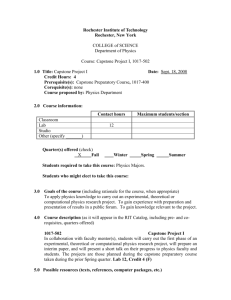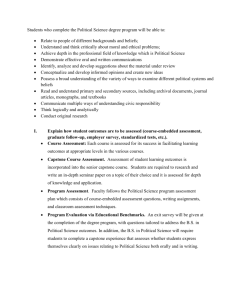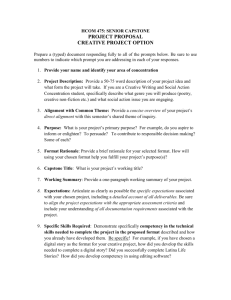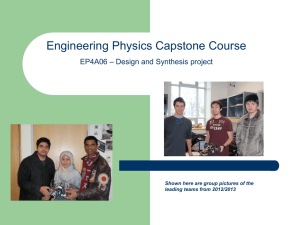Senior Project Framework
advertisement
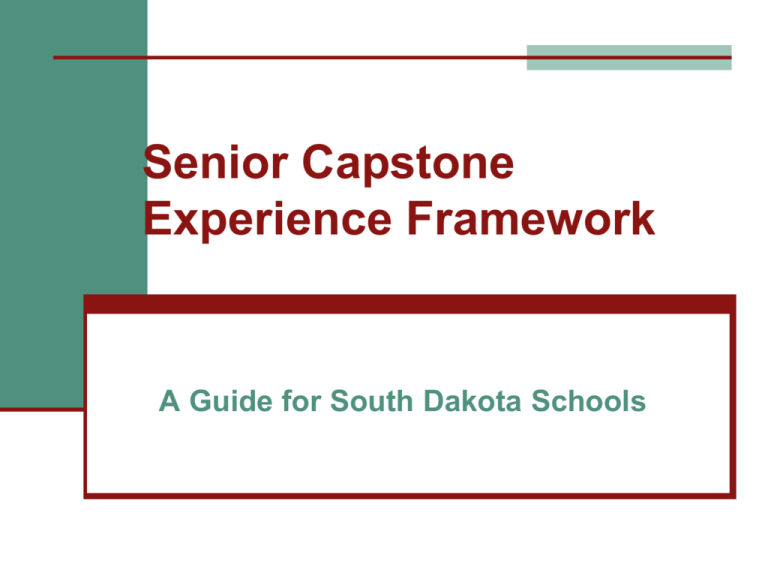
Senior Capstone Experience Framework A Guide for South Dakota Schools Senior Capstone Experience What are Senior Capstone Experiences? Why implement Senior Capstone Experiences? How do we implement Senior Capstone Experiences? Where do we find the time? “Enter to Learn: Leave to Achieve” A Rationale for Senior Capstone Experiences…. Senior Capstone Experiences….. Prepares student for post-secondary with: Research Analysis Developing a Product Completing a Portfolio Completing 15 hours of Mentoring Presentation The Senior Experience… is a high school capstone that requires students to demonstrate not only what they know, but what they can do. States, school districts, and high schools focusing on restructuring, raising high school standards, and actively engaging all Seniors in a challenging and relevant educational process incorporate the Senior Capstone Experience. Elements of a High Quality Senior Capstone Program Clear and Aligned Purpose Explicit, Rigorous Criteria Authentic Project Community Involvement Coordination and Comprehensive Communication Adequate Staffing and Supervision Parent Involvement Celebration and Recognition Implementing the Senior Capstone Experience Organize Plan Design Implement Evaluate Step One: Organizing What are the goals for the Project? Does the administration support the program? Does the staff support the program? Who are key people that should be involved? Has funding been allocated? What is our timeline? Step Two: Planning Assign duties and responsibilities Address anything that can prove to be detrimental Alleviate fears of students and parents Be upfront and honest Explain the purpose Explain cost and time commitment Explain benefits Determine how the program will fit into your curriculum. Senior Experience Options Project imbedded in a core subject Project offered as a stand-alone course Project offered as a semester course Project offered as a year long course Project is a requirement for high school graduation Project is assigned a letter grade Project is graded by pass/fail Project Personnel What personnel do you need?? Senior Project Coordinator Faculty Advisors (if you choose to do this) English Teacher(s) Project Mentors Panel of Judges Step Three: Designing This step involves identifying and tailoring the components for your school. This is the “big picture” piece. Roles and Responsibilities Student It is the responsibility of the student to meet all guidelines and timelines for the Senior Experience. Faculty Advisor All professional staff members are available as advisors. Advisors should be limited to no more than five advisees to be able to effectively work with each one. OR One Advisor coordinates the entire program with help from faculty members in finding mentors. Roles and Responsibilities English Teacher(s) The English teacher is responsible for monitoring the research phase of the Project. Senior Project Mentor Each student must have a Mentor who has expertise/experience with the topic. The Mentor must commit to working with the student for 15 hours. Senior Experience Coordinator Schools should have one person designated as the Coordinator. This could be a paid position with release time provided. The Four Project Phases How will these components fit together? Paper Product Portfolio Presentation Initial Documents and Forms Senior Capstone Guidelines Letter to Parents Project Timelines Point Breakdown Topic Selection Guidelines Topic Selection Worksheet Topic Proposal Topic Approval Form Letter of Intent Topic Change Form Your Action Plan will Serve as Your Compass… The Research Paper What are the guidelines for your school? Baltic’s Research Paper Guidelines 8-10 pages in length Several Checkpoints MLA format Five sources minimum Bibliography Note Cards Noodle Tools Stress research vs. report The Product The product can be oriented around the performance of a skill, the development of some physical product, or the study of a profession. It is an appropriate and logical outgrowth/extension of the research paper. It demonstrates application of knowledge. Powerpoint does not equal Product! Projects Require a Learning Stretch, Which is… An addition to the student’s own knowledge or skill Something they haven’t tried yet Searching for answers to questions they have about a topic. The Portfolio Sections: Required Documents Research Paper Topic approval form, signed mentor forms, typed overview, reflection, etc. Outline, bibliography, polished final draft Journal Product Evidence of Work – pictures, materials collected, etc. Baltic’s portfolio checklist and rubric (show example portfolio) The Journal Each weekly entry should cover the following: Describe what was done on the Senior Capstone Experience that week. Write a personal reaction or evaluation of what was done that week. Baltic: 1/3 page of Word document, submitted through Web CT The Presentation The Senior Experience Presentation is the culminating event, which must include the entire learning experience. It should reflect elements of the paper, product and the portfolio. Baltic: 2 nights, practice night in the works Rubric Program and Student Evaluation Program Evaluation – should be a yearly event. What worked well? What didn’t? What are we going to change for next year? Student Evaluation – How are we going to evaluate student results? What rubrics should we use? Should one phase count more than the other? Are we making any gains in student achievement? Evaluate at the conclusion of each school year. Contact Information Marsha Kucker – mkucker@edec.org High Schools That Work State Director office - 367-7680 cell – 280-0650 Scott Fossum – scott.fossum@mitchelltech.edu Central Area Tech Prep Director office – 800-MTI-1969 995-3072
